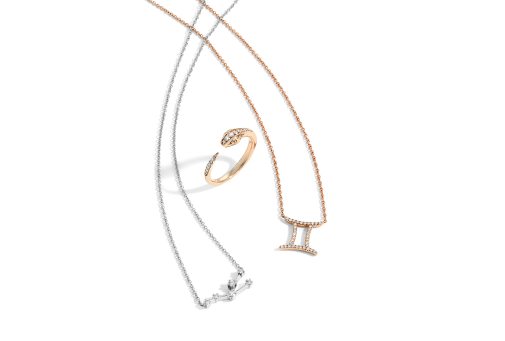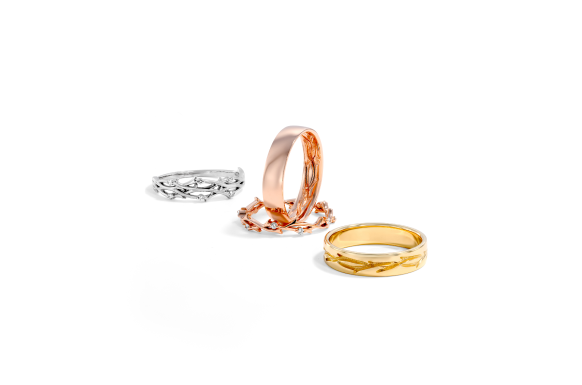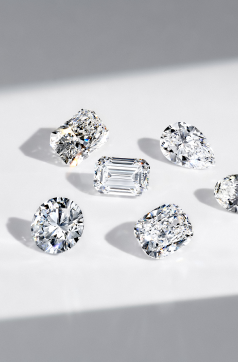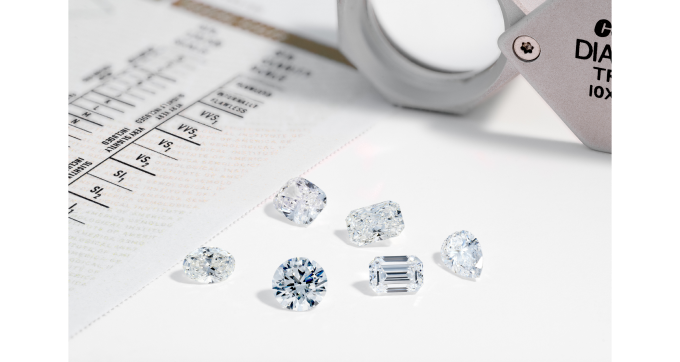Everything You Need to Know About Prong Settings
Education Center
Education CenterEverything You Need to Know About Prong Settings
When it comes to engagement rings, few design elements are as iconic as the prong setting. This timeless style lets the center stone shine with effortless elegance, drawing all eyes to its brilliance. Beloved for its classic beauty and ability to maximize sparkle, the prong setting is a favorite across a range of styles, from sleek solitaires to radiant halos.
In this guide, we’ll walk you through everything you need to know about prong settings: the different styles, their unique benefits, and how they pair beautifully with a variety of diamond shapes.
What Is a Prong Setting?
With a prong setting, small metal claws hold the center stone securely in place. These prongs grip the diamond from different angles, usually at the corners or sides, raising it slightly above the band. This lifted position allows maximum light to hit the stone, amplifying its sparkle and brilliance.
Prong engagement rings are beloved for their versatility. This setting complements a wide range of styles, from classic to contemporary. They come in a variety of shapes to accommodate varying needs and preferences.
-
Pointed Prongs: Pointed prongs, also known as claw prongs, grip the diamond with discreet coverage. They allow more light to pass through the stone, enhancing its sparkle while keeping the setting chic and refined.
-
Rounded Prongs: Rounded prongs have a soft, bead-like appearance, creating a delicate, feminine frame around your center stone. They subtly highlight the diamond’s brilliance without overpowering it.
-
Flat Prongs: Flat prongs, also known as tab prongs, feature a squared-off tip that sits flush against the diamond. This low-profile design boosts stability and reduces the chance of snagging, making it a practical and polished choice for everyday wear.
-
V-Shaped Prongs: V-prongs are specially designed to protect the pointed ends of more angular diamond shapes. Marquise, pear, and princess cut stones benefit from this type of setting, which shields delicate tips from chips or snags. The V-shape hugs the corner of the stone, blending protection with a streamlined finish.
-
Tulip Prongs: Tulip prongs form a basket-like design around the diamond, resembling the elegant shape of a blooming flower. They add a romantic, sculptural beauty to the ring while offering exceptional security for your center stone.
-
Shared Prongs: Shared prongs are typically used in band styles featuring multiple diamonds. Instead of separate prongs for each stone, adjacent diamonds share one prong between them. This creates an uninterrupted line of sparkle and allows more light to pass through each gem.
-
Double Prongs: Double prongs feature two slender prongs placed closely together at each corner of the stone. They add visual interest and secure the diamond, making them ideal for larger or more valuable diamonds. Double prongs often appear in vintage-inspired designs, offering a graceful balance of charm and durability.
Benefits of Prong Settings
There’s a reason prong settings have stood the test of time. They offer a mix of beauty, brilliance, and practicality that few other settings can match.
The biggest advantage is the way prongs allow light to enter the diamond from all angles. With minimal metal obstructing the stone, the result is a radiant, fiery sparkle that enhances the diamond’s natural brilliance. This is especially important for shapes like round and oval, which rely on maximum light refraction.
Prong settings also make the diamond the undeniable focal point of the ring. They lift the stone above the band just enough to give it a presence without overwhelming the design. Plus, they’re easy to clean and maintain, which is essential for everyday wear. Their timeless silhouette complements almost every ring style, making them a smart and stylish choice for anyone.
Disadvantages of Prong Settings
While prong-style engagement rings are beloved for their timeless beauty and brilliant sparkle, there are a few things to keep in mind. Thin or delicate prong settings can be more vulnerable to wear and may break over time if not properly cared for. Diamonds set higher on the band create an eye-catching look but can sometimes catch on fabrics or bump into surfaces, making them a less practical choice for those with active lifestyles. To keep your ring looking as stunning as the day you got it, we recommend having the prongs inspected regularly to ensure they remain secure and in perfect shape.
Advantages |
Disadvantages |
|
They are discreet and don’t detract from the diamond. |
Thin settings could break over time. |
|
They allow for an abundance of light to pass through for elevated fire and brilliance. |
Highly set diamonds may get caught on material or bump into things. |
|
They are relatively simple to make and cheaper than other settings. |
Highly set diamonds may not serve active lifestyles. |
|
Maintenance and cleaning routines are straightforward. |
Less-secure settings could loosen over time. |
|
Sizes, styles and shapes are customizable and versatile. |
They should be inspected regularly. |
|
The timeless design transcends trends. |
|
Prong Settings by Diamond Shape
Different diamond shapes call for prongs that blend security with style. Round diamonds work with four prongs for extra sparkle or six prongs for a timeless frame while oval stones pair with claw or double prongs to accentuate their elongated form. Princess cuts rely on V-prongs to protect their corners while pear shapes use standard prongs plus a V-prong at the tip to secure the point and highlight its asymmetrical charm. By matching prong style to each diamond shape, you’ll ensure a secure setting that showcases its beauty for years to come.
How to Choose the Right Prong Setting
When selecting a prong setting, start by thinking about your personal style. If you love delicate details, consider claw or four-prong settings that let the diamond shine with minimal metal. If you prefer something bold or want extra protection, six-prong or double prong settings offer a little more structure without sacrificing beauty.
Security is another key factor. A well-set prong holds the diamond firmly in place, even with everyday wear, though occasional checks are recommended to make sure everything stays secure. If you prefer even more protection with minimal maintenance, you might consider a vintage bezel setting, which surrounds the stone: it’s perfect for active lifestyles or anyone who wants added peace of mind.
Is a Prong Setting Your Perfect Match?
Prong settings suit those who want to put the diamond front and center. Claw and four-prong styles offer clean, minimal lines, which is perfect for those who value refined simplicity. Six-prong and double-prong options deliver extra grip without hiding sparkle, so they’re ideal for anyone wanting a bit more structure for their engagement ring. They’re a go-to for showcasing brilliance, whether for everyday wear or special occasions.
Elegant. Secure. Timeless.
Prong settings have earned their reputation as one of the most elegant and enduring choices for engagement rings. Their ability to showcase the diamond’s brilliance while maintaining a lightweight, classic look makes them a favorite across generations. Whether you love the minimalism of four prongs or the sculptural detail of double prongs, there’s a style that’s perfect for you.



